CoinWeek Ancient Coin Series by Mike Markowitz …..
MAJESTIC, POWERFUL, SWIFT, and intelligent, the eagle has held a strong grip on human imagination since the earliest times. The bald eagle, native to North America, features prominently on the Great Seal of the United States, and on many classic and modern American coins. The U.S. $10 gold piece was called an “Eagle”, and the current one-ounce silver bullion coin bears the same name.
The golden eagle (Aquila chrysaetos), native to the Old World, is frequently seen on ancient coins. A search for the term “eagle” on the Coin Archives Pro database, which currently lists over 1.8 million auction records, found 128,257 hits. “Eagle” and “Tetradrachm” (a common collectable ancient) produced 24,099 records. Eagles appear on eight coins listed in Harlan J. Berk’s 100 Greatest Ancient Coins.
Ionia
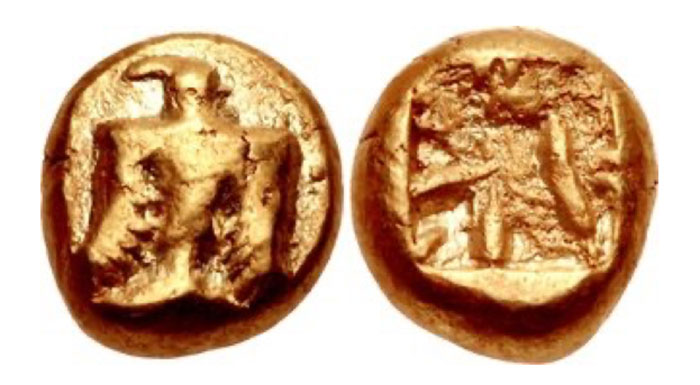
The earliest appearance of an eagle on a coin dates from about 600-550 BCE: an electrum hekte (or “one-sixth stater,” 1.86 gram) from an uncertain mint in Ionia, on the eastern shore of the Aegean Sea. The bird is shown with wings outspread, the posture called “eagle displayed” in heraldry (Fox-Davies, 233). A unique, similar coin with a pelleted border and struck on a different weight standard (2.58 grams) is cited as “one of the earliest attempts in numismatic art to represent a bird in flight (Rosen, 13)”.
Abydos
A more sophisticated rendering of an eagle appears a century later on an electrum stater, possibly from Abydos (near modern Canakkale, Turkey). The bird stands with closed wings, its head turned looking backward.
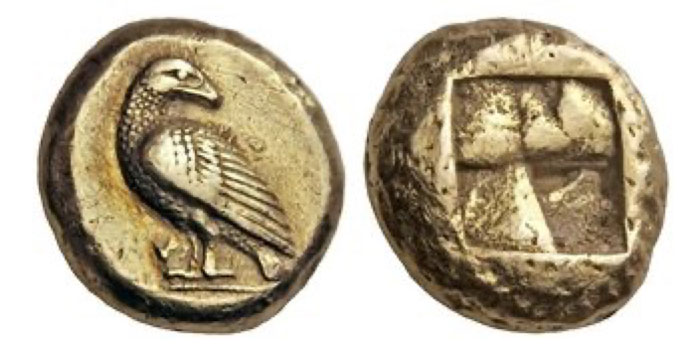
A cataloguer writes:
“As the animal-familiar of Zeus, the eagle makes numerous appearances on Greek coins, yet it seldom occurs as a standalone design with the bird in a distinctive pose, such on this stater[1].”
The individual wing feathers are carefully engraved on this rare coin. Only three examples are known
Kroton
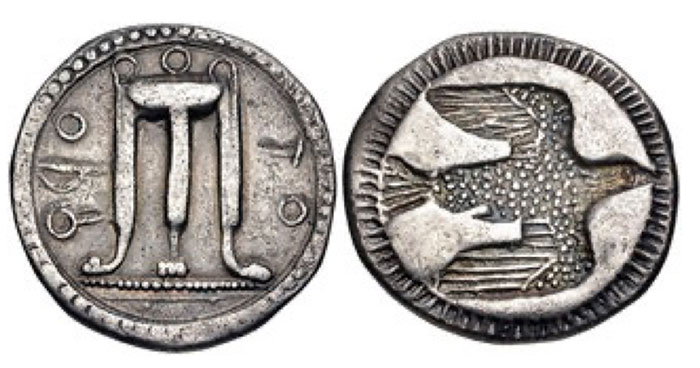
The city of Kroton (or Croton) in the southern Italian region of Calabria was founded in 710 BCE by Greek colonists. The philosopher and mathematician Pythagoras founded his school there circa 530 BCE. Because his father was a gem engraver, and because these artisans also carved the dies used the strike ancient coins, some numismatists have speculated that Pythagoras was involved somehow in the design of Kroton’s distinctive coinage. On a silver nomos issued c. 500-480 BCE, the reverse is an incuse flying eagle, with the feathers on the body represented as dots[2]. An “incuse” design, technically difficult to execute well, is sunk below the otherwise flat surface of the coin[3].
Olympia
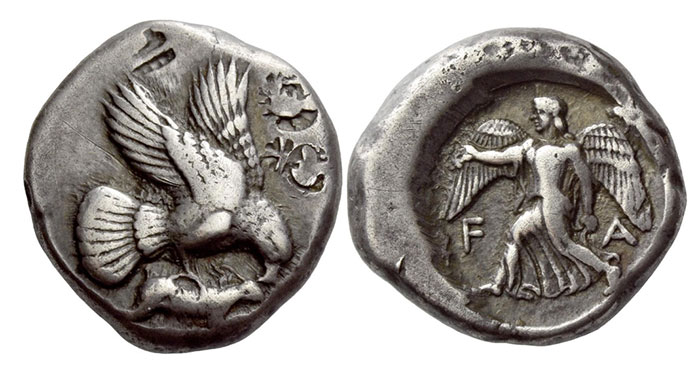
The city of Elis in Greece managed the sacred site of Olympia, where the Olympic games were held every four years beginning in 776 BCE. Foreign coins were not accepted at the games, so visitors had to exchange their money for special issues that produced a tidy profit for Elis.
For about two centuries, Elis maintained a high standard of artistry on this coinage, which often included an eagle, the companion of Zeus. A lifelike eagle in flight, grasping a hare in its talons and tearing it with its beak appears on a coin of Elis, struck c. 450-440 BCE and pedigreed to the famous Spencer-Churchill collection[4], realized over $32,000 USD in a 2019 Swiss auction[5].
Akragas

Akragas (today Agrigento) on the south coast of Sicily was the island’s second-largest city after Syracuse. About 409 BCE, Akragas issued a massive silver dekadrachm (a 10 drachma piece, weighing over 42 grams) to honor a local hero, Exainetos, winner of the Olympic chariot race. The obverse, by the master engraver Myron, shows the sun god Helios driving his chariot across the sky as an eagle soars above. The reverse, attributed to the engraver Polyainos, shows a pair of eagles exulting over a hare they have just killed.
On Berk’s list of the 100 Greatest Ancient Coins, this type is #8 (p. 50). It brought $572,000 in the 1990 sale of the Nelson Bunker Hunt collection. When it appeared again at auction in October 2012, the bid was $2,477,647–a world-record price for an ancient coin[6]. The buyer, an Arab sheik, reportedly never paid for it. Less than 10 specimens of this coin are known. A few years ago, I saw the British Museum’s specimen on loan to the local museum in Agrigento. A pair of carabinieri armed with submachine guns stood guard to either side of the display case.
Alexander the Great

When Alexander the Great conquered the Persian Achaemenid Empire, he captured a vast store of precious metal — by one estimate some 200,000 talents[7] or almost 6,000 tons — that the Persians had hoarded for centuries. He ordered this silver and gold to be struck into coins and put into circulation, vastly expanding the money supply of the ancient Mediterranean, fueling almost three centuries of social, cultural, and economic development known to modern historians as the Hellenistic era[8].
On the reverse of his silver tetradrachm, Alexander placed an image of Zeus enthroned, an eagle perched on his extended right hand. On well-executed high-grade coins, the bird and the god almost seem to be locked in eye contact. On Harlan Berk’s list of the 100 Greatest Ancient Coins, this type is #20 (63). The coin proved so popular that it was still issued by numerous mints for centuries after Alexander’s death at Babylon in 323 BCE. An exceptional example, “among the finest known,” brought $5,500 in a 2018 US auction[9].
Perseus
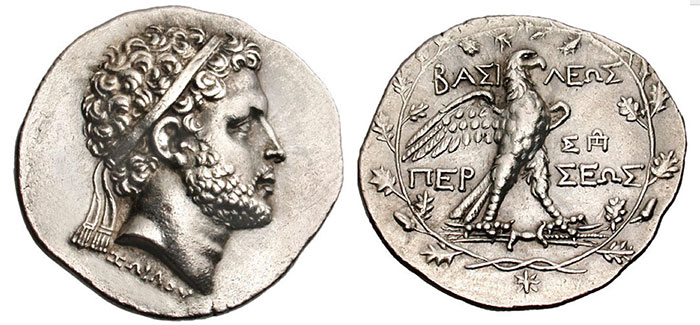
Perseus was the last king of Macedon, ruling territory in northern Greece and the Balkans. The growing involvement of Rome in Greek affairs led to repeated wars. The armies clashed near the town of Pydna in 168 BCE, and the Macedonian phalanx was quickly routed by the Roman legions.
Perseus lived out the rest of his life in comfort as a guest of the Roman Republic. A silver tetradrachm possibly issued for the coronation of Perseus in 179 or 178 BCE bears a bold portrait of the king, with the name “Zoilos” (either the engraver or a mint official; opinions are divided) inscribed below[10]. On the reverse, a slender eagle grasps a thunderbolt in his talons, surrounded by a wreath of oak leaves and acorns.
A cataloguer writes:
“The spectacularly fine portrait, and the beautifully made eagle, are among the glories of all Hellenistic Greek coinage.”
On Berk’s list, this type is #67 (p. 78). Only about 30 examples are known.
Gold Coins of the Roman Republic

Gold was not a regular part of the Roman Republic’s circulating coinage and was only issued for wartime emergencies. In 211 BCE, during the war against Hannibal, a series of handsome gold coins appeared, denominated as 60, 40, and 20 asses. The bronze as was a standard Roman unit of value. These are some of the few ancient coins inscribed with their denominations. The reverse bears an eagle clutching a thunderbolt, above the word ROMA. Greek die engravers were probably employed for this special issue. Only about 11 examples of the 40 as type are known[11].
On Berk’s list of the 100 Greatest Ancient Coins, this type is #71 (Berk, 75).
Cleopatra
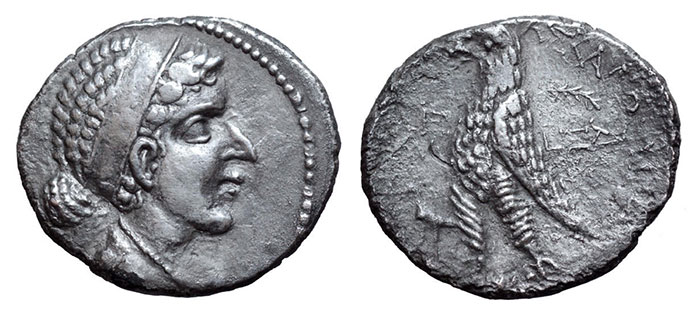
On Berk’s list of the 100 Greatest Ancient Coins, this type is #30 (82). Only about four examples are known.
The Shekel of Tyre
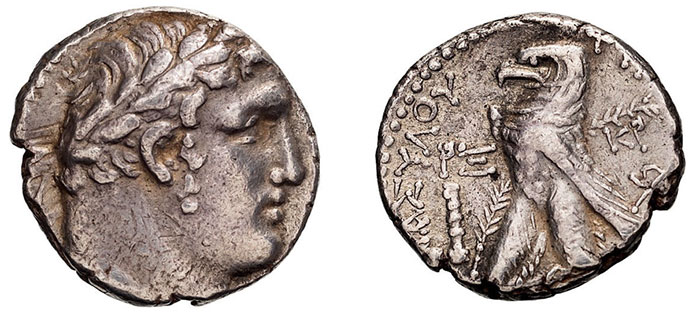
The Phoenician trading city of Tyre (now Sur, Lebanon) was famed for the purity of its silver shekel. They were the only coins accepted by the Temple in Jerusalem for payment of the annual tax required of all Jews, even though they bore the image of a pagan god, Melqarth, and a living creature, the eagle. This technically breached the Commandment against “graven images.[13]”
Around 19 BCE, the purity of Tyrian shekels fell from 95% to just 80%, creating a crisis for the Temple authorities. The priests decided to set up their own mint to strike coins of acceptable fineness[14]. This may have been in Jerusalem, but some sources dispute this. The Israeli numismatist Ya’akov Meshorer (1935-2004) wrote “as an expression of contempt for the Tyrian design on the shekels, the Jerusalem mint executed them with demonstrative crudity.”
On Berk’s list of the 100 Greatest Ancient Coins, this type is #62 (94).
Elagabalus

Of all the emperors who ruled Rome, Elagabalus (218-222 CE) is surely the strangest, with his sexual eccentricities scandalizing conservative Romans. But like most emperors, Elagabalus’ improbable rise to the throne was due to the “game” played by power brokers behind the scenes; in this instance, that played by his powerful grandmother, Julia Maesa, sister of the empress Julia Domna. On coins, Elagabalus used the name “Antoninus Pius” – ironic, since this was also the name of the most straight-laced emperor of the second century (ruled 138-161).
Elagabalus was the hereditary high priest of a Syrian sun god in the city of Emesa (now Homs), worshipped in the form of a conical black stone thought to be a meteorite (it may go without saying, but stones that fell from the sky powerfully affected the imagination of ancient people). Curiously, the image of an eagle was believed to appear on the stone’s surface. On the reverse of a gold aureus of Elagabalus, we see the stone borne on a ceremonial chariot, with the inscription CONSERVATOR AVG (“Preserver of the Emperor”).
In a 2013 Swiss auction, an example of this coin, “extremely rare and among the finest specimens known,” sold for over $114,000[15]. On Berk’s list, this type is #76 (p. 112).
Severus
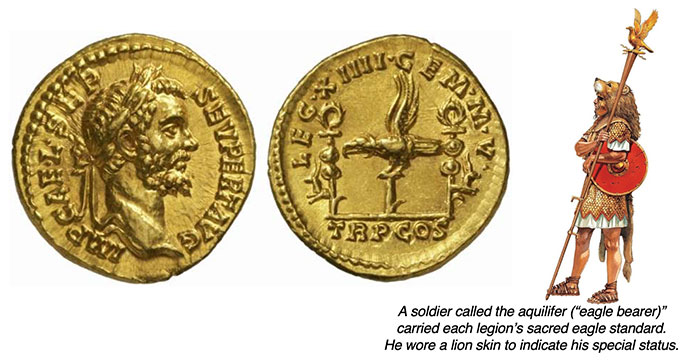
Each Roman legion carried a gilded silver eagle on a pole as its sacred standard. Losing an eagle in battle was a disgrace, and Rome made extraordinary efforts to retrieve any eagles captured by her enemies. A veteran soldier called the aquilifer (“eagle bearer”) carried the standard. He wore a lion’s pelt draped over his helmet indicating his special status.
Legionary eagles, and lesser small-unit standards called signa, appear frequently on Roman coins, notably on the common legionary denarii of Mark Antony. An outstanding later example is a gold aureus of Septimius Severus, struck in 193 CE to honor Legion XIV (Gemina Martia Victrix)[16].
Note that the legion’s number is written as XIIII. The “subtractive” notation of Roman numerals (“IV” for 4, “IX” for 9, and “XL” for 40) was a later development).
The Ostrogoths

After the collapse of the Roman Empire in the West, much of Italy was ruled by the Ostrogoths from their capital at Ravenna on the Adriatic. Surrounded by marshes, Ravenna was highly defensible.
The city of Rome had fallen into a long decline, but a mint located there continued to strike coins, including small change in bronze.
Eagles appear frequently in Ostrogothic art, notably on jeweled brooches used to fasten cloaks[17]. An eagle clutching a palm branch appears between two stars on a rare decanummium (a four-gram coin that might have been the price of a loaf of bread or a cup of cheap wine) struck c. 493-518[18].
Small change was in chronic short supply in the ancient world and often remained in circulation until worn flat. It is unusual for a decanummium to survive in good condition.
* * *
Notes
[1] NAC Auction 88, October 8, 2015, Lot 410. Realized CHF 60,000 (about $62,048 USD; estimate CHF 60,000).
[2] CNG Electronic Auction 439, March 6, 2019, Lot 8. Realized $5,500 USD (estimate $3,000).
[3] The U.S. $5 half eagle and $2.50 quarter eagle gold coins, issued from 1908 to 1929, were incuse on both sides.
[4] Captain Edward G.Spencer-Churchill (1876-1964) was a noted collector of art and antiquities and a cousin of British statesman Winston Churchill.
[5] NAC Auction 116, October 1, 2019, Lot 149. Realized CHF 32,000 (about $32,083 USD; estimate CHF 18,000).
[6] NAC Auction 66, October, 17, 2012, Lot 6. Realized CHF 2,300,000 (about $2492,144 USD, but never actually paid; estimate CHF 1,750,000).
[7] The Attic talent was 26 kg (57 pounds) of nearly pure silver; see https://coinweek.com/coinweek-podcast/coinweek-podcast-145-ancient-coin-weight-standards
[8] https://en.wikipedia.org/wiki/Hellenistic_period
[9] Goldberg Auction 106, September 4, 2018, Lot 1034. Realized $5,500 USD (estimate $2,000).
[10] Harlan J Berk, Sale 178,March 15, 2012, Lot 58. Realized $14,750 USD
[11] NAC Auction 45, April 2, 2008, Lot 5. Realized CHF 120,000 (about $118,203 USD; estimate CHF 40,000).
[12] Roma Numismatics Auction 13, March 23 2017, Lot 428. Realized £70,000 (about $87,686 USD; estimate £50,000).
[13] Exodus, 20:4-6
[14] Harlan J, Berk Sale 204, July 18, 2018, Lot 112. Realized $1,500 USD (estimate $1,300).
[15] NAC Auction 72, May 16, 2013, Lot 698. Realized CHF 110,000 (about $114,643 USD; estimate CHF 60,000).
[16] NAC Auction 24, December 5, 2002, Lot 128. Realized CHF 13,000 (about $8,834 USD; estimate CHF 14,000).
[17] https://www.themorgan.org/objects/item/290015
[18] NAC Auction 75, November 18, 2013, Lot 418. Realized CHF 1,500 (about $1,645 USD; estimate CHF 1,200).
References
Berk, Harlan. 100 Greatest Ancient Coins. 2nd edition. Pelham, AL (2019)
Fox-Davies, A.C. A Complete Guide to Heraldry. New York (1978)
Francisco, John. “Pythagoras and the Incuse Coins of Magna Graecia”, Celator 26 (April 2012)
Kraay, Colin. Archaic and Classical Greek Coins. New York (1976)
Meshorer, Ya’akov. A Treasury of Jewish Coins: From the Persian Period to Bar Kokhba. Amphora Books (2001)
Rosen, Jonathan. Archaic Coins: An Exhibition at the J.Paul Getty Museum. Malibu, CA (1983)
* * *
 Mike Markowitz is “Second Consul” of the Ancient Numismatic Society of Washington. He has been a serious collector of ancient coins since 1993. He is a wargame designer, historian, and defense analyst, who writes for StrategyPage and Defense Media Network. He designed the game Alexandros, which won the 1991 Charles Roberts Award for “Best Pre-WWII Wargame”. He has degrees in History from the University of Rochester, New York and Social Ecology from the University of California, Irvine. He has worked as a technical writer, editor and trainer for a variety of aerospace and defense firms. Born in New York City, he lives in Fairfax, Virginia.
Mike Markowitz is “Second Consul” of the Ancient Numismatic Society of Washington. He has been a serious collector of ancient coins since 1993. He is a wargame designer, historian, and defense analyst, who writes for StrategyPage and Defense Media Network. He designed the game Alexandros, which won the 1991 Charles Roberts Award for “Best Pre-WWII Wargame”. He has degrees in History from the University of Rochester, New York and Social Ecology from the University of California, Irvine. He has worked as a technical writer, editor and trainer for a variety of aerospace and defense firms. Born in New York City, he lives in Fairfax, Virginia.





Mr.Markowitz: su nota me resultó particularmente interesante, porque me fascinan tanto las águilas como las monedas antiguas. Por otra parte, nunca deja de asombrarme la calidad y el talento de los grabadores de esos tiempos, sobre todo en los retratos. Muchas gracias por compartir este material.